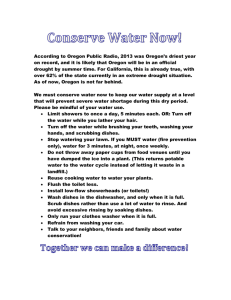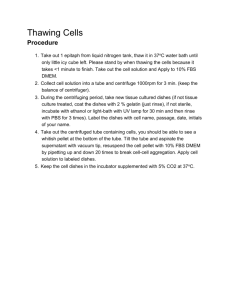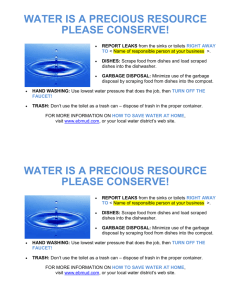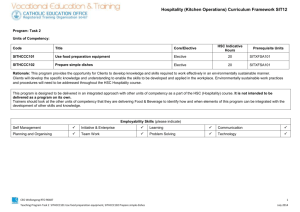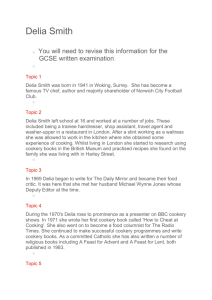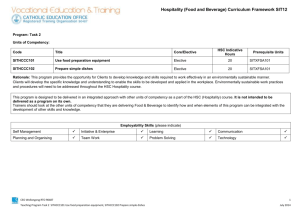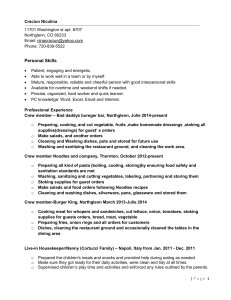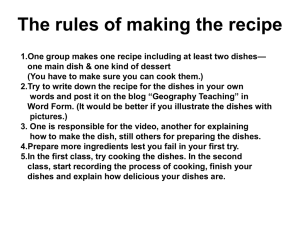Teaching Program Term 3 & 4 KO
advertisement
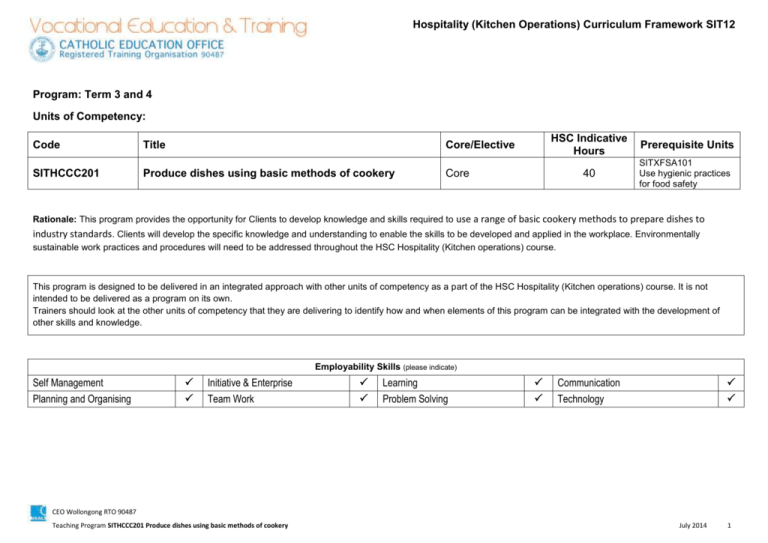
Hospitality (Kitchen Operations) Curriculum Framework SIT12 Program: Term 3 and 4 Units of Competency: Code Title Core/Elective SITHCCC201 Produce dishes using basic methods of cookery Core HSC Indicative Hours Prerequisite Units 40 SITXFSA101 Use hygienic practices for food safety Rationale: This program provides the opportunity for Clients to develop knowledge and skills required to use a range of basic cookery methods to prepare dishes to industry standards. Clients will develop the specific knowledge and understanding to enable the skills to be developed and applied in the workplace. Environmentally sustainable work practices and procedures will need to be addressed throughout the HSC Hospitality (Kitchen operations) course. This program is designed to be delivered in an integrated approach with other units of competency as a part of the HSC Hospitality (Kitchen operations) course. It is not intended to be delivered as a program on its own. Trainers should look at the other units of competency that they are delivering to identify how and when elements of this program can be integrated with the development of other skills and knowledge. Employability Skills (please indicate) Self Management Planning and Organising Initiative & Enterprise Team Work Learning Problem Solving Communication Technology CEO Wollongong RTO 90487 Teaching Program SITHCCC201 Produce dishes using basic methods of cookery July 2014 1 Hospitality (Kitchen Operations) Curriculum Framework SIT12 HSC requirements and advice – key terms and concepts: Required Skills ▪ ▪ ▪ ▪ ▪ ▪ ▪ ▪ ▪ ▪ ▪ initiative and enterprise skills to minimise wastage literacy skills to read menus, recipes and task sheets numeracy skills to: calculate the number of portions weigh and measure ingredients determine cooking times and temperatures planning and organising skills to work in a logical and planned way problem-solving skills to respond to problems in the cooking process self-management skills to: work safely in the kitchen deal with pressure of work and kitchen conditions technology skills to use food preparation and cooking equipment. Required Knowledge Key Terms and Concepts ▪ characteristics of different food types, their use in different dishes and the effects of different cookery methods on those foods, including: ▪ ▪ ▪ ▪ ▪ ▪ ▪ ▪ ▪ ▪ ▪ ▪ ▪ ▪ dairy products dry goods fruit general food items: batters coatings condiments and flavourings garnishes oils sauces meat poultry seafood vegetables ▪ the meaning and role of mise en place in the process of preparing, cooking and presenting food ▪ culinary terms and principles and practices of different cookery methods including: ▪ ▪ ▪ ▪ ▪ ▪ ▪ ▪ ▪ ▪ ▪ ▪ ▪ ▪ ▪ ▪ ▪ ▪ baking blanching boiling braising deep-frying grilling poaching roasting shallow frying: pan-frying sauté stir-frying steaming stewing microwaving contents of stock date codes and rotation labels equipment used for cookery methods: essential features and functions safe operational practices. CEO Wollongong RTO 90487 Teaching Program SITHCCC201 Produce dishes using basic methods of cookery July 2014 2 Hospitality (Kitchen Operations) Curriculum Framework SIT12 SITHCCC201 Produce dishes using basic methods of cookery 1. Select ingredients. Element Performance criteria Range Statement 1.1 Confirm food production requirements from food preparation list and standard recipes. Food production requirements may include: ▪ deadlines ▪ portion control ▪ quantities to be produced ▪ special customer requests ▪ special dietary requirements. 1.2 Calculate ingredient amounts according to requirements. Content: BOSTES Requirements and Advice (if applicable) Learning experiences/ Assessment activities Resources Registration/ Signature and Date produce food for multiple customers within commercial time constraints 1.3 Identify and select ingredients from stores according to recipe, quality, freshness and stock rotation requirements. CEO Wollongong RTO 90487 Teaching Program SITHCCC201 Produce dishes using basic methods of cookery July 2014 3 Hospitality (Kitchen Operations) Curriculum Framework SIT12 SITHCCC201 Produce dishes using basic methods of cookery 2. Select, prepare and use equipment. Element Performance criteria 2.1 Select equipment of correct type and size. 2.2 Safely assemble and ensure cleanliness of equipment before use. 2.3 Use equipment safely and hygienically according to manufacturer instructions. Range Statement Equipment may include: ▪ bains marie ▪ blenders ▪ cooking ranges: ▪ electric ▪ gas ▪ induction ▪ crockery ▪ cutlery ▪ food processors and mixers ▪ knives and knife sharpening equipment ▪ fryers ▪ grills and griddles ▪ microwaves ▪ ovens ▪ pans ▪ salamanders ▪ scales ▪ slicers ▪ steamers ▪ thermometers ▪ utensils. Content: BOSTES Requirements and Advice (if applicable) Learning experiences/ Assessment activities Resources Registration/ Signature and Date ▪ Integrate knowledge of: ▪ major food types, culinary terminology and equipment as they relate to the required methods of cookery ▪ features, functions and safe use of food preparation equipment ▪ food safety practices for handling and storing different food types. CEO Wollongong RTO 90487 Teaching Program SITHCCC201 Produce dishes using basic methods of cookery July 2014 4 Hospitality (Kitchen Operations) Curriculum Framework SIT12 SITHCCC201 Produce dishes using basic methods of cookery Element Performance criteria Range Statement 3. Assemble and prepare ingredients. 3.1 Weigh and measure ingredients and create portions according to recipe. 3.2 Prepare, cut and portion ingredients according to recipe and cooking style. 3.3 Minimise waste and store reusable by-products. Content: BOSTES Requirements and Advice (if applicable) Learning experiences/ Assessment activities Resources Registration/ Signature and Date ▪ follow standard recipes for dishes that together use all of the following ingredients: ▪ dairy products ▪ dry goods ▪ fruit ▪ general food items ▪ meat ▪ poultry ▪ seafood ▪ vegetables ▪ complete mise en place activities for different dishes CEO Wollongong RTO 90487 Teaching Program SITHCCC201 Produce dishes using basic methods of cookery July 2014 5 Hospitality (Kitchen Operations) Curriculum Framework SIT12 SITHCCC201 Produce dishes using basic methods of cookery Element Performance criteria Range Statement 4.1 Use cookery methods for dishes following standard recipes. Dishes may include: ▪ appetisers ▪ breakfast items ▪ café-style items 4. Cook dishes. 4.2 Complete cooking process in a logical and safe manner. 4.3 Identify problems with the cooking process and take corrective action. 4.4 Work cooperatively with colleagues to ensure timely preparation of dishes. Content: BOSTES Requirements and Advice (if applicable) ▪ Use a range of cookery methods to prepare dishes including: ▪ Baking ▪ Blanching Dishes of limited ▪ Boiling complexity: ▪ Braising ▪ containing a small ▪ Deep-frying number of ▪ Grilling ingredients ▪ Poaching ▪ requiring a single ▪ Roasting cookery method ▪ Shallow frying: ▪ fast food ▪ Pan-frying ▪ partially-prepared ▪ Sauté items ▪ Stir-frying ▪ pasta dishes. ▪ Steaming ▪ Stewing ▪ Microwaving Learning experiences/ Assessment activities Resources Registration/ Signature and Date Practical Assessment: TAPAS 4.5 Present dishes according to recipe. CEO Wollongong RTO 90487 Teaching Program SITHCCC201 Produce dishes using basic methods of cookery July 2014 6 Hospitality (Kitchen Operations) Curriculum Framework SIT12 SITHCCC201 Produce dishes using basic methods of cookery Element Performance criteria Range Statement Content: BOSTES Requirements and Advice (if applicable) Learning experiences/ Assessment activities Resources Registration/ Signature and Date CEO Wollongong RTO 90487 Teaching Program SITHCCC201 Produce dishes using basic methods of cookery July 2014 7
